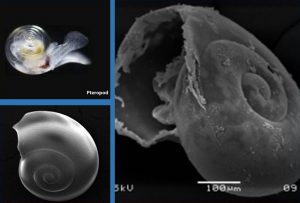It’s Not Easy Being Shelled: The Ocean Acidification Blues
Meg Chadsey, NOAA’s Washington Sea Grant and the NOAA Pacific Marine Environmental Lab in Seattle, WA
Excess carbon dioxide (CO2) isn’t just warming the planet; it’s also reacting with seawater and making the oceans more corrosive—a process known as ocean acidification. This slight increase in acidity doesn’t change the way the ocean looks or feels to us—but it’s a big deal for marine species with hard parts made of calcium carbonate, like pteropods, whose delicate shells begin to dissolve when exposed to acidified seawater. Meg Chadsey will demonstrate how ocean acidification is stressing her favorite local shellfish species—oysters—and explain why some shellfish farmers are turning to kelp for help.
Resources to access at home:
» Lego Calcification Challenge Activity
» Red Cabbage Ocean Acidification in a Cup Activity
» Rosemary Mosco’s Ocean Acidification Cartoon: pretty much everything you need to know about OA in 8 panels
» What is Ocean Acidification: A Crash Course – a 2-minute animated video, drawn by Sherman’s Lagoon cartoonist Jim Toomey
» Washington Sea Grant Ocean Acidification webpage
» The Power of Kelp: a 6-minute video about the benefits of kelp farming
» Washington Sea Grant’s Kelp Aquaculture webpage: a deep dive into the many uses for farmed kelp
» Tracking Ocean Acidification in Puerto Rico Video: this 8-minute video is in Spanish with an English subtitle option
» Ocean Acidification and Clownfish: This is a ~5-minute video

